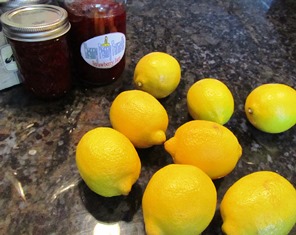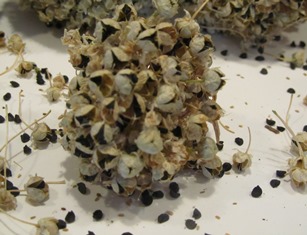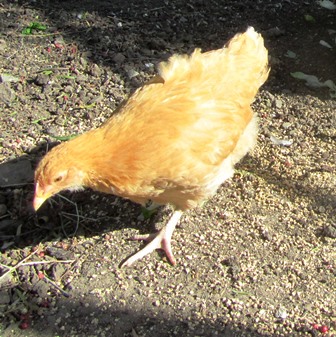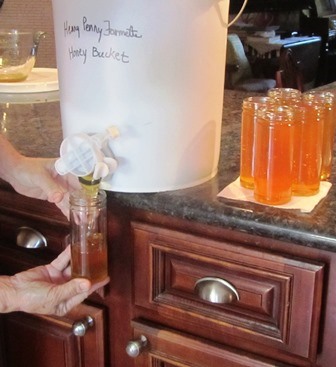Archive for August, 2015
Deadline Nears for My Debut Novel Giveaway
It’s not too late to enter the Goodreads giveaway of A BEELINE TO MURDER, my debut novel from Kensington Publishing. This is the first book in the Henny Penny Series, set in a farmette milieu and featuring sleuth Abigail Mackenzie, a former cop turned farmette owner.
The murder of a small town’s celebrity pastry chef remains central to this cozy mystery, however, Abby must juggle chores on the farmette (a foreclosed property she acquired that needs clearing, cleaning, and restoration) with paying detective work. Although she keeps bees and chickens and sells her organic honey, eggs, and heirloom produce, the income is never enough to pay the bills and fund the renovation work.
The concept for this series came about as a result of my purchase of the real Henny Penny Farmette–a rundown property that I bought in 2009. The work of bringing the land back to life and renovating the house is some of the hardest work I’ve ever done. And it seems it will never end.
Like the protagonist of my novel, I keep bees and chickens. I grow heirloom vegetables and tend the dozens of fruit trees I’ve planted.
I draw upon real life issues involving weather, wild and domesticated animals, human relationship conflicts, and community dramas to seed the background of my murder mysteries.
I love writing about the people in the fictional small town of Las Flores. Except for growing up on a farm in the Midwest and spending two years in Miami, I have lived in Northern California’s cities and small towns for most of my life. Drawing upon the peculiarities of small town life, I have created the community of Las Flores with vivid details that I hope will ring true for my readers.
The deadline to enter the drawing for A BEELINE TO MURDER is August 31 (Monday). I hope you’ll take a moment to join the fun. You might just win one of the 25 copies being given away. See, https://www.goodreads.com/giveaway/show/147966-a-beeline-to-murder
Bougainvillea Vines Are Valued for Their Vibrant Color
If you’re looking for something that gives dense cover with green leaves and has prolific flower production, think about planting some bougainvillea vines. After my husband recently picked up four bougainvilleas in gallon-pots from our local nursery where the plants were on sale, we planted them around the front porch.
When you buy them in pots during spring and summer, you can pick bract color. The nearly inconspicuous blooms are surrounded by large, vibrantly colored bracts. Color choice ranges from red, orange, pink, fuchsia, deep purple, and white.
You’ll need to protect these evergreen shrubby vines where frost is expected. They’ll benefit from being moved to a warm wall. In fact, bougainvillea will thrive in the warmest parts of the garden. That said, they may even need a little shade protection in extremely hot areas.
Since the roots aren’t interwoven tightly in a root ball, you’ll want to plant them with care or slice the sides of your plastic gallon pot a half-dozen times, fold back, and plant pot and all in the planting hole.
Spring and summer are the best times to fertilize. Prune to renew the plant in the spring after the danger of frost is over. Many bougainvillea plants are tall growing varieties but you can also find some considered low- to medium-growing shrubs. These vines are show-stoppers with curb appeal and an even better value when you get them discounted at your local plant nursery.
Plum and Prune Trees Reward with Foliage, Blooms, and Fruit
We are growing several plum and prune trees here on the farmette, but because some were given to us as shoots from other people’s trees we don’t know the exact identity of some of our trees. However, the fruit from them is delicious.
A plum we are growing along the back fence of our property produces tons of bloom and lots of small-to-medium fruit with deep red coloring. The tree is self-fertile. Fruit aside, the tree has lovely dark reddish-purple leaves, spring to summer. We like the foliage so much that when it sprouted (plums love to sprout new shoots), we culled a couple of sprouts for new trees. Now we have three of those plums on our property and believe the cultivar to be a European Damson.
Another plum given to us is a yellow variety. The first year we lived here, that plum tree gave us a large-size crock bowl full of sweet, yellow, good-quality fruit. We believe it is self-fertile (although we keep honeybees and our neighbor’s have plum trees that quite possibly pollinate ours).
We are aware of a couple of yellow plums. One is a Japanese cultivar–Shiro–that produces a golden yellow plum with yellow flesh. Another is a European variety–Yellow Egg–that is self-fertile and produces large, oval, yellow-fleshed fruit. I do not know if the tree we are growing belongs to either of these types.
Last spring, we planted a self-fertile French prune–Agen. The fruit is small, red to purplish black with a sweet taste. It’s a late producer but is the standard drying prune for California. It can also be canned.
Plum and prune trees aren’t too fussy about soil, but they do respond to a feeding now and then. Japanese plums can easily take one to three pounds of nitrogen annually, while European plums will do well with one to two pounds of nitrogen.
Pruning is required. Japanese plums benefit from severe pruning at all stages (prune to a vase shape). European plums should also be trained to the vase shape and benefit from an annual pruning when the trees are mature to thin out shoots.
Thinning fruits (one fruit for every four inches) as soon as they form will yield stronger trees and larger fruit. As for pest, use an organic dormant spray for pests that winter over. Otherwise, plum and prune trees are joy to grow in the garden for their foliage, blooms, shade, and fruit.
Why We Should Love Toads
What is brown, relatively smooth-skinned, and burrows into dry soil in Western gardens? The answer is the Western spadefoot toad, and there are plenty of reasons to invite them them into making their home near yours.
They like to dine on cutworms, flies, grasshoppers, slugs, grubs, wood lice, and other small insects. In fact, a single spadefoot toad will eat roughly 10,000 to 20,000 insects a year. And that’s just from spring until fall, when they go into hibernation.
After eating all those insects, you’d think they might head for your vegetable patch or flowers. But no, they aren’t interested in harming your herbs, flowers, or veggies.
We can help these toads set up housing in our gardens by creating a shallow impression in the soil and placing a board or two over it, leaving just enough room for the toad to hop in. For an image and to hear the sound of the spadefoot toad, see: http://www.californiaherps.com/frogs/pages/s.hammondii.html
Like most living creatures, they need water. A water garden, pond, or even a ground-level plant saucer or bird bath will do the trick. An added benefit of a water garden or small pond is its attractiveness to toads to lay their eggs, ensuring generations of toads in your garden for years to come.
Protecting Your Backyard Flock in a Heat Wave
I lost a chicken this morning despite taking measures to protect her from the deadly heat wave we’ve been having here in the Bay Area. The last thing someone attached to their hens ever wants to see is one of her precious little girls gone. Mine was a Silver Laced Wyandotte (who leaves behind a sister) and five other hens with whom she was raised.
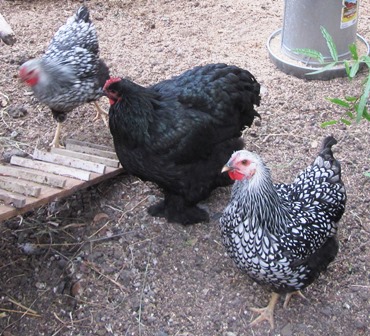
The Silver Laced Wyandotte (black-and-white) hen in the foreground succumbed to the extreme heat sometime during the night
Our farmette sits in the east bay hills and too far inland from the San Francisco Bay or the delta (which flows to Sacramento) to gain much benefit from cooling breezes off the ocean. We’ve had triple digit temps on the farmette for days.
I put out extra water basins for my chickens, kept their doors open in the chicken house at night (there is a wire run with a wire ceiling to protect them when they’d rather roost outside), and fed them frozen corn, cool seedless watermelon treats, and chilled grapes.
The chicken house has windows that I keep open (they have reinforced wire over the screens). I reduced the amount of litter on the floor (I use ground corn cob) since it could hold the heat.
I haven’t install a fogging system or fans, but I might if this heat keeps up.
The only telltale sign that my hen was in trouble was that she seemed to exhibit lethargy and to have lost weight (although it was difficult to tell under all her feathers).
Her comb had turned slightly pale and seemed to have shrunk in the last 24 hours. When I check on her last night she was turning herself to face the wall. Not a good sign since, in my experience, I’ve seen chickens do this before they pass away.
Some strategies for helping backyard chickens survive extreme heat include the following tips.
Eight Strategies to Help Chickens Beat the Heat
1. Make sure windows of chicken houses face north to south to allow breezes to blow through, rather than face east to west (rising and setting sun).
2. Keep litter on the chicken house floor low (1 to 2 inches is sufficient).
3. Position your chicken house under a tree, if possible, where the structure receives shade.
4. Make certain you have several watering dispensers (placed in the shade) with clean, fresh water every day during hot weather.
5. Add ice cubes to the watering canisters.
6. Put out treats such as bowls of frozen corn and cool, seedless watermelon, and chilled grapes or blueberries.
7. Use a fan, if necessary to remove heat from the chicken house.
8. As an emergency measure for a chicken that looks distressed, dip her in cool water.
Growing a Meyer Lemon Tree
Meyer Lemon is California’s favorite backyard fruit tree. Here, in the Bay Area, I am growing it on my farmette along with Satsuma tangerines, blood oranges, naval oranges, and lime trees. We love marmalade made from our citrus as well as juice, pickles, and desserts.
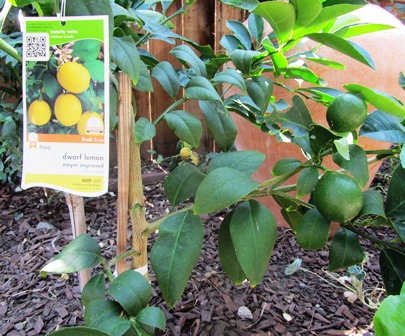
Leaving the tag attached for the first year can guide a gardener to caring for the plant according to grower recommendations
In two beds at the front of my property along a fence line, I’ve planted several citrus trees, among them, an improved Meyer lemon.
First introduced from China to the United States in 1908, Meyer Lemon takes its name from an agricultural explorer with the USDA named Frank Nicholas Meyer. These beautiful thin-skinned lemons are more round, juicier, and less acidic than their counterparts Lisbon and Eureka. It takes four years to grow one tree from seed. Today, the improved Meyer is widely available in California.
In the 1940s, Meyer lemons were believed to be carriers of the Citrus tristeza and tatter leaf viruses. Although these viruses did not harm the Meyers, it harmed other varieties of lemons grown by commercial growers. Ergo, the California department of Food and Agriculture dictated that the Meyer lemons would have to be eradicated. See, https://en.wikipedia.org/wiki/Meyer_lemon
In the 1950s a virus-free selection was identified and then in 1975, an improved Meyer was cloned. It tested free of those viruses, resulting in this new, “improved” Meyer Lemon again being planted in California. If you love the bright flavor and the clean, fragrant scent as well as the versatility of this lemon that can be roasted, salted in brine, drizzled into cake, made into pie, and even candied, consider planting an improved Meyer Lemon tree. They are vigorous growers that produce a bountiful crop.
Six Steps to Growing a Meyer Lemon
1. Plant in a container (the method many Chinese gardeners love) or in the ground.
2. Dig in a south-facing spot that will receive plenty of sunlight (at least eight hours per day).
3. Water when needed, but don’t over-water; this citrus likes a good drenching and then a chance to dry-out.
4. Four times per year, apply organic citrus fertilizer and water it into the roots.
5. Give support to young trees against wind, and thin fruit on young trees until they are are well established.
6. Prune off branches after the late winter/spring harvest to keep them (or the fruit) from touching the ground.
Gathering Seed for Next Year’s Garden
The sounds of summer around our farmette have grown quieter. It’s mid-August and the neighborhood children have returned to school. I miss their laughter. I miss the delight on their faces at seeing the chickens and the honeybees. I miss keeping them company at their lemonade stand.
But I admit to the secret pleasure of solitude and quiet, though it isn’t really silence. It’s the peaceful clucking of chickens and the twitter of songbirds as I gather seed from plants that have bloomed and dried, such as the cosmos, nasturtiums, sunflowers, and wisteria.
The wisteria vine that exploded in growth of long, green tendrils during spring and early summer and graced us with bracts of purple perfusion now hold heavy pods. The pods contain seeds that can be dried and planted for new vines next year.
The sword-shaped leaves of the irises are dry–their blooms a memory from early spring. I’ve already cut their long leaves back into four-inch fans and will dig some of the rhizomes for replanting in other beds around the farmette.
The sunflowers that the bees love to forage on have gone to seed. Those seeds will become next year’s plants, but some we’ll save for the squirrels.
The red and yellow onions have developed seed pods on long shoots now. I’ll plant those in raised beds in the fall for a spring crop of onions.
Yes, the dog days of summer have come around again. But the growing season continues. End of summer gives rise to autumn when grapes, persimmons, pumpkins, figs, and pomegranates ripen. On the farmette, there is always another season and other crops to look forward to with anticipation. It’s the good life.
Update on the Buffo Broodzilla
My Buff Orpington hen, who’d been sitting on a couple dozen infertile eggs for weeks–some rotten and others broken–finally left the nesting box after I removed all the eggs. I’ll be set up for baby chicks next year in my hen house, but not now.
At first, she continued to display her broodzilla behaviors (aggressive, flighty, angry) and was easily set off by the antics of the other chickens. However, within a day or two, she’d normalized her old laying routine and began running with the other hens as they foraged around the farmette, took dust baths, clamored for chicken snacks, and pecked at each other.
My neighbor told me to dunk her in cold water to break her broody cycle. That’s because hens who go broody have an elevated body temp. Removing the eggs worked this time; maybe next time, I’ll try cooling her off. Or . . . if it happens in the spring, I might get some baby chicks and let her raise them.
I’m certain there will be a next time–she’s gone broody three times in a year and half. Some hens have that tendency.
A Good Day to Strain, Drain, and Bottle Honey
It’s Sunday. I’m bottling the honey that I pulled from the hives last week. Yesterday, I washed two dozen eight-ounce jars in the dishwasher and allowed them to dry upside down on paper towels. Today, I’ll put on my apron and listen to some energetic big band tunes while I drain that honey into jars.
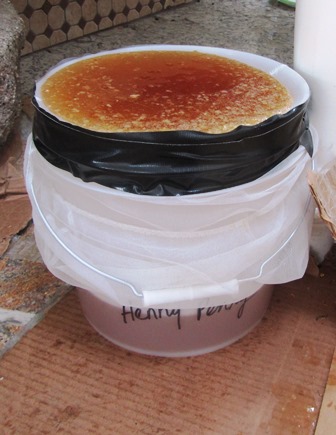
The fine mesh strainer taped tightly around the bucket rim traps the bits of wax but does not impede the flow of honey
My buckets of honey still have duct tape around their rims holding the strainers in position. When the honey was spun in the extracting machine, it had to be drained through a filter. Painter’s filters work great as the mesh cloth is very fine and fits over the top of the bucket.
The filter is placed into position around the rim and then duct taped is wrapped around tightly two times. Honey is quite heavy and can pull down the filter if not secured. I’m straining the honey that goes into jars. However, I did save back a jar of unfiltered honey with all those bits in it for a family member who prefers it that way.
The work was easier and went faster than I’d expected. It helps to have everything you need close at hand, clean, and ready to go.
Of the three large buckets, the first had a nice spigot than I could turn off after I allowed honey to flow and fill the jar. Then I closed the spigot, wiped the jar with a damp paper towel, and then screwed the lid in place.
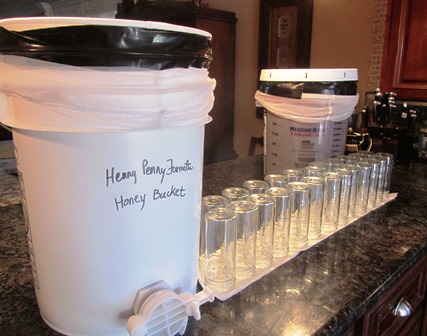
This five-gallon honey bucket will fill approximately five dozen eight-ounce jars; pictured here are 24 jars
The two dozen eight-ounce jars barely made a dent in my first honey bucket although my neighbor tells me that I can easily fill five dozen of the eight-ounce jars from one five-gallon bucket; or, I can fill two and one-half dozen of the sixteen-ounce jars.

Filled jars reveal clear, light amber honey the bees made from the French perfume lavender on my farmette and our springtime flowers, but these jars still labels
The next step in the process is to affix my Henny Penny label onto the jar. I plan to give some of these jars away during promotions in early October for my forthcoming novel, A BEELINE TO MURDER, the first in the Henny Penny Farmette series of cozies.
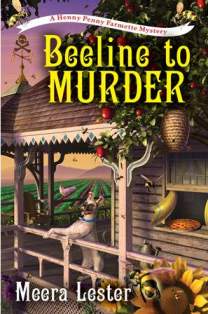
Published next month by Kensington, my book is available on Amazon, Barnes & Noble, and through most booksellers and online bookstores
If you are interested in this honey, please feel free to email me at meeralester1@gmail.com.
 Facebook
Facebook Goodreads
Goodreads LinkedIn
LinkedIn Meera Lester
Meera Lester Twitter
Twitter








